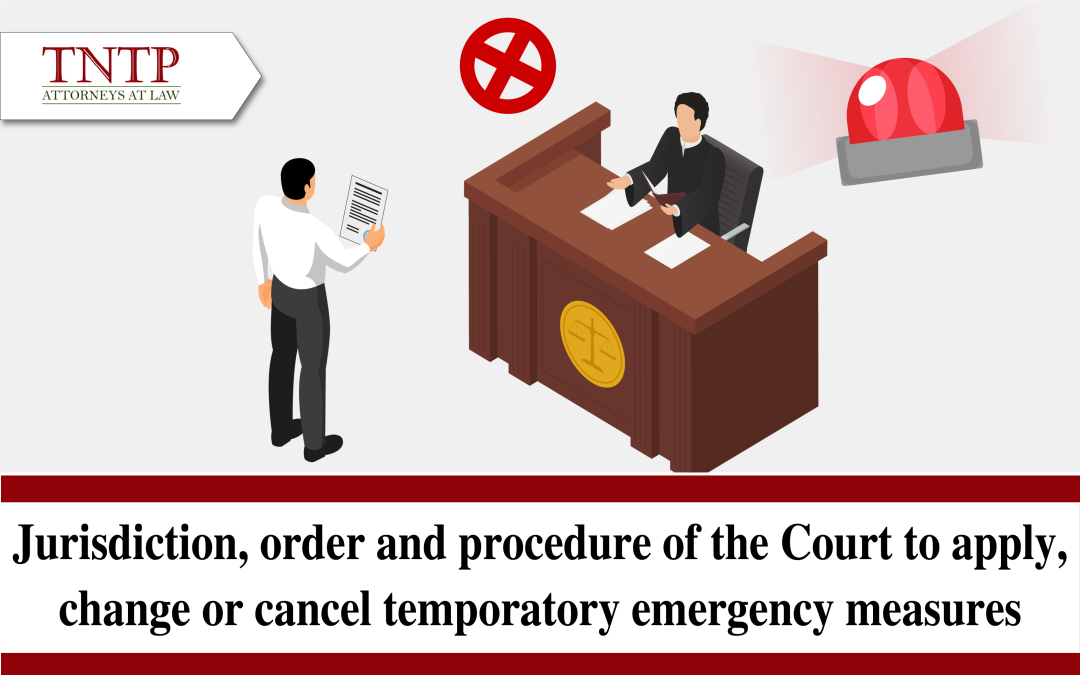The Court is the competent authority to receive and resolve the parties’ request to apply temporary emergency measures. When submitting the request, the parties must attach documents and evidence to prove the necessity of the application of temporary emergency measures. So what is the authority and procedure of the Court when resolving the request and issuing a decision to apply, change or cancel temporary emergency measures? In this article, TNTP lawyer will give the opinion on this matter.
1. Jurisdiction of the Court to apply, change or cancel temporary emergency measures
Pursuant to Article 112 of the Civil Procedure Code 2015, competence to apply, change or cancel temporary emergency measures:
• Before the trial session, the application, change or cancellation of temporary emergency measures shall be considered and decided by a Judge.
• In the Court sessions, the application, change, cancellation of temporary emergency measures shall be considered and decided by the trial panel.
Thus, it is necessary to base on the time of each case at that time to determine two cases corresponding to two times in which a Judge or Trial Panel will decide to apply, change, or cancel temporary emergency measures.
2. Liability of the Court in applying incorrect temporary emergency measures
Pursuant to Clause 2, Article 113 of the Civil Procedure Code 2015, which stipulates the liability for incorrect application of temporary emergency measures, if the Court applies incorrect temporary emergency measures and causing damage to the person subject to the temporary emergency measures or a third party, the Court must compensate if it falls under one of the following cases:
• The Courts have applied the temporary emergency measures on their own;
• The Courts have applied other temporary emergency measures than those petitioned by agencies/organizations/individuals;
• The Courts have applied the temporary emergency measures that goes beyond the petitions of agencies, organizations and individuals;
• The Courts have applied the temporary emergency measures that is not comply with the time limit prescribed by law or the Courts fail to apply the temporary emergency measures without good and sufficient reasons.
Thus, before issuing a decision to apply temporary emergency measures, the Court needs to carefully review, examine, and consider the cases to apply the correct and appropriate temporary emergency measures accordingly. When there is an error that results in damage to the person subject to the measure or a third party, the Court will have to compensate for the damage according to the provisions of the Law on State Compensation Liability.
3. Procedures for requesting the application, change or cancellation of temporary emergency measures
(i) A person requesting the Court to apply temporary emergency measures must submit an application to the competent Court with documents and evidence proving the necessity of applying temporary emergency measures.
(ii) The application for temporary emergency measures must have the following main contents:
• Date, month, year of writing the application;
• Name, address, telephone number, fax, email address (if any) of the person requesting the application of temporary emergency measures;
• Name, address, telephone number, fax, email address (if any) of the person requested to apply temporary emergency measures;
• Summarize the content of the dispute or the act of infringement of your legitimate rights and interests;
• Reasons for the need to apply temporary emergency measures;
• Temporary emergency measures to be taken and specific requirements.
(iii) Depending on each case, the Court or Trial Panel will resolve the request to apply temporary emergency measures as follows:
• In case of requests for application of temporary emergency measures as prescribed in Clause 1, Article 111 of the Civil Procedure Code 2015:
• In case the Court receives a request before opening the trial, the Judge assigned to resolve the case must consider and resolve it.
Within 03 working days from the date of receipt of the application, if the applicant does not have to implement security measures or immediately after that person completes the security measures as prescribed, the Judge must immediately issue a decision to apply temporary emergency measures.
If the request is not accepted, the Judge must notify the requester in writing and state the reasons.
• In case the Trial Panel receives a request for temporary emergency measures at the trial, the Trial Panel will consider, discuss, and resolve the request in the courtroom. If accepted, the Trial Panel will issue a decision to apply temporary emergency measures immediately or after the applicant has completed the security measures as prescribed.
The implementation of security measures shall begin from the time the Trial Panel issues a decision to enforce the implementation of security measures, but the applicant must present evidence of the completion of security measures before the Trial Panel enters the deliberation room.
If the request for temporary emergency measures is not accepted, the panel of judges must immediately announce it in the courtroom and record it in the minutes of the trial.
• In case of requests for application of temporary emergency measures as prescribed in Clause 2, Article 111 of the Civil Procedure Code 2015:
Upon receipt of the request together with the petition and accompanying evidence, the Chief Justice of the Court shall immediately assign a Judge to resolve the request.
Within 48 hours from the time of receipt of the request, the Judge must consider and decide to apply temporary emergency measures; if the request is not accepted, the Judge must notify the requester in writing and state the reasons.
• In case of applying temporary emergency measures as prescribed in Clauses 10 and 11, Article 114 of the Civil Procedure Code 2015, only accounts and assets with a value equivalent to the property obligations that the person subject to temporary emergency measures is obliged to perform may be frozen.
(iv) For changes and additions to temporary emergency measures
When it is found that the temporary emergency measure being applied is no longer suitable and it is necessary to change or apply another temporary emergency measure, the procedure for changing or applying another temporary emergency measure shall be carried out according to regulations.
(v) For the cancellation of the application of temporary emergency measures
• The Courts shall immediately issue decisions to cancel the applied temporary emergency measures in one of the following cases:
– It is so petitioned by the persons who have petitioned the application of temporary emergency measures;
– The persons who are obliged to execute the decisions on application of temporary emergency measures hand over the property or other person performs security measures toward the petitioners;
– Civil obligations of the obligor terminate as provided for in the Civil Code;
– The resolution of the cases is terminated according to regulations in the Civil Procedure Code;
– The decisions on application of temporary emergency measures are inconsistent to the provisions of this Code;
– The grounds for application of the temporary emergency measures are no longer existed;
– The cases have been resolved with judgments/decisions of the Courts that have become effective;
– The Courts have returned the lawsuit petitions as prescribed in Civil Procedure Code.
Thus, depending on the request for the application of temporary emergency measures, the applicant must provide the Court with evidence to prove the need for the application of temporary emergency measures. Then, the Court or the Trial Panel will base on the request and the evidence documents depending on each case to decide to apply temporary emergency measures. In case the Court needs to change, supplement, or cancel the application of temporary emergency measures, the Court needs to check and compare with the regulations to decide to change or cancel the application of temporary emergency measures to ensure it aligns with the circumstances the case.
Above is an article by TNTP on “Jurisdiction, order and procedures of the Court to apply, change and cancel temporary emergency measures”. We hope this article will be helpful to readers.
Sincerely,







